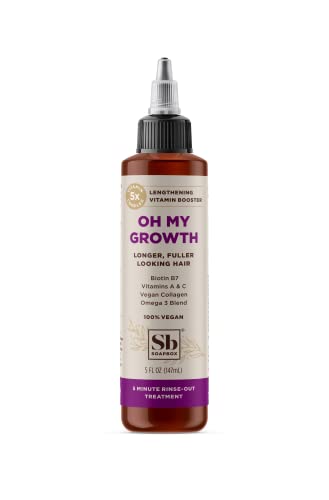
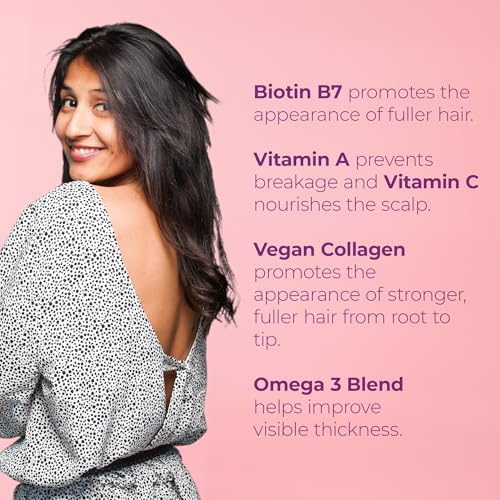
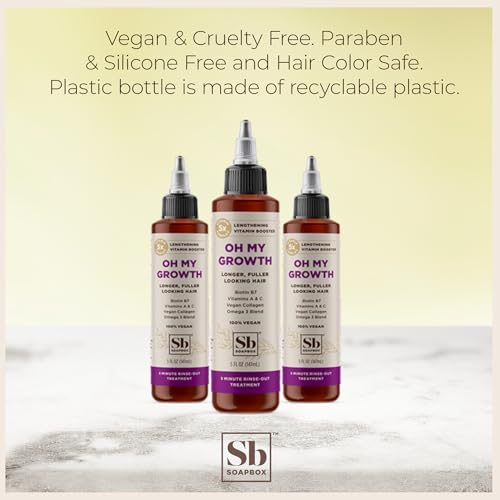
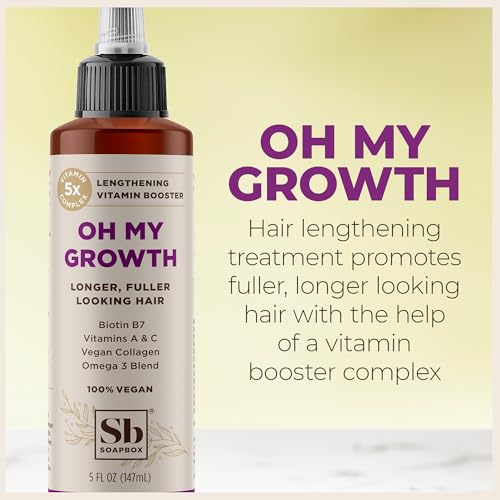
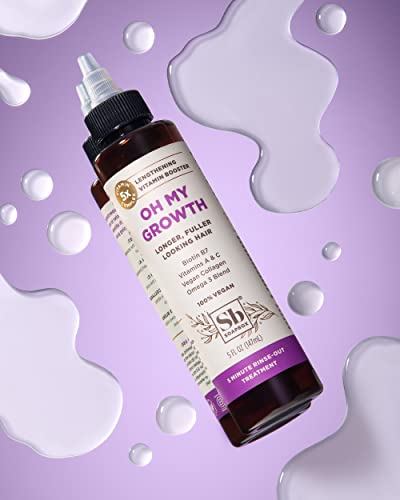
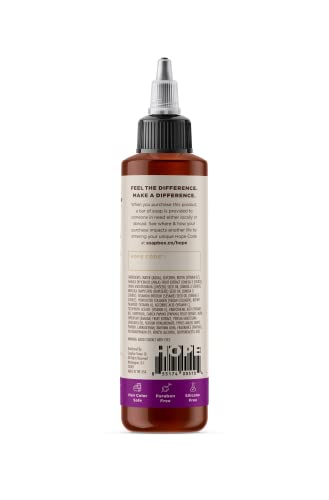
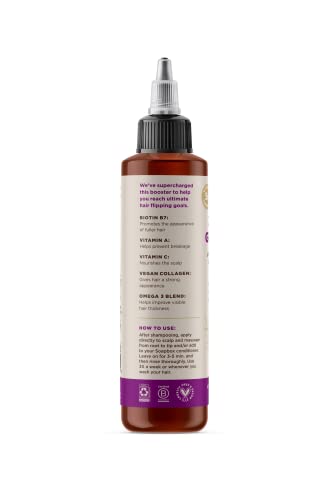
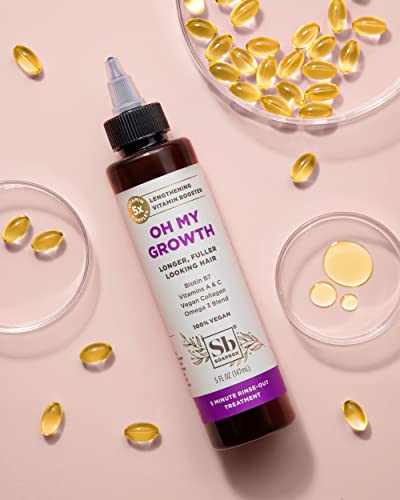
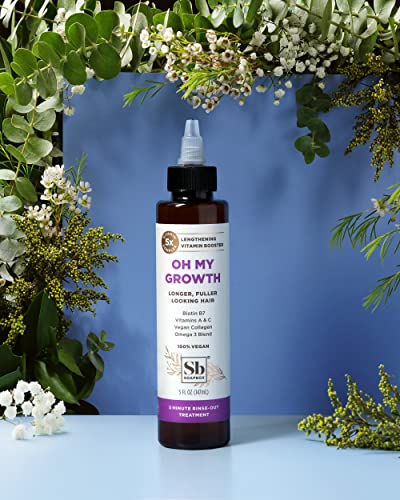
Soapbox Hair Treatment - Promotes Fuller Hair with Biotin & Vegan Collagen - 5oz


Benzyl Alcohol
High RiskBenzyl alcohol is a naturally occurring and synthetic aromatic alcohol commonly used as a solvent, preservative, and fragrance ingredient in various products. It is found in both plant sources and as a synthetic compound, functioning primarily to maintain product stability and enhance fragrance profiles.
Sustai Insights
Benzyl alcohol serves effectively as a preservative and solvent, contributing to product stability and sensory qualities. However, it poses potential health risks, particularly as an allergen, with high concern for immunotoxicity. Environmental risks include being a pollutant with low bioaccumulation potential. Regulatory agencies have established restrictions on its use in certain products. Overall, the risk level associated with benzyl alcohol is assessed as high, necessitating careful consideration of its use and potential alternatives.
Polyquaternium 39
High RiskPolyquaternium-39 is a polymeric quaternary ammonium compound commonly used in personal care products for its conditioning and film-forming properties. It enhances the texture, manageability, and appearance of hair and skin by providing a smooth, soft feel.
Sustai Insights
Polyquaternium-39 is effective as a conditioning agent, enhancing product performance and user experience. However, it is associated with high usage restrictions and potential skin irritation, with low concerns regarding cancer, allergies, and reproductive toxicity. Its environmental risks include pollution potential, necessitating careful formulation. Regulatory bodies have set guidelines limiting its use. Overall, the risk level is assessed as high due to these combined factors. Safe usage practices should be observed, and alternatives like natural conditioning agents may be considered.
Fragrance
High RiskFragrance refers to a mixture of aromatic compounds used in products to provide scent. It is commonly listed as 'fragrance' or 'parfum' on product labels and can serve various functions, including enhancing user experience and masking undesirable odors.
Sustai Insights
Fragrance offers functional benefits by improving product appeal; however, it poses significant health risks, notably a high likelihood of causing allergies and allergic contact dermatitis. Environmental risks include potential pollution and endocrine disruption, though its overall carcinogenicity is low. Regulatory bodies have noted concerns regarding its use, leading to a high-risk classification. Safe usage practices should be observed, and alternatives such as natural essential oils are recommended for those sensitive to synthetic fragrances.
Retinyl Palmitate (Vitamin A Palmitate)
High RiskRetinyl palmitate, also known as vitamin A palmitate, is an ester of retinol and palmitic acid. It serves primarily as a skin-conditioning agent, promoting skin health and rejuvenation through its role in cellular turnover and differentiation. This ingredient is commonly used in cosmetic formulations.
Sustai Insights
Retinyl palmitate offers functional benefits such as enhancing skin texture and providing anti-aging effects. However, it is associated with high developmental and reproductive toxicity concerns, while also posing moderate risks for carcinogenicity. Environmentally, it may contribute to pollution and bioaccumulation. Regulatory bodies have imposed use restrictions due to these health risks, leading to an overall high-risk assessment. Safe usage practices are essential, and alternatives like retinol or plant-derived vitamin A sources may be considered.
Retinol (Vitamin A)
High RiskRetinol (vitamin A) is a naturally occurring substance primarily known for its role in skin health, often included in products aimed at improving skin texture and reducing signs of aging. It functions as a potent ingredient in skincare formulations, enhancing cellular turnover and promoting collagen production.
Sustai Insights
Retinol offers functional benefits such as enhancing skin absorption and improving skin appearance through increased turnover and collagen synthesis. However, its usage is associated with high concerns regarding developmental and reproductive toxicity and potential irritation. Environmental risks include its contribution to pollution, while regulatory bodies impose strict usage restrictions. Overall, the risk level is assessed as high, necessitating careful consideration in its application and the exploration of safer alternatives.
Thuja Occidentalis (Arborvitae)
Medium RiskThuja occidentalis, commonly known as arborvitae, is a coniferous tree native to North America. It is often used in cosmetics and personal care products for its potential antimicrobial properties and as a fragrance component. Its essential oil is extracted for various applications in aromatherapy and traditional medicine.
Sustai Insights
Thuja occidentalis offers functional benefits, including antimicrobial properties and use as a natural fragrance. However, it may pose moderate allergenic risks and is not associated with significant health concerns like carcinogenicity or reproductive toxicity. Regulatory assessments indicate low restrictions on its use. Environmental impacts include potential for irritation and moderate toxicity to aquatic life. Overall, its risk level is categorized as medium, suggesting careful consideration during usage. Alternatives include other plant-based oils with similar benefits but lower allergenic potential.
Brassica Campestris (Rapeseed) Seed Oil
Low RiskBrassica campestris (rapeseed) seed oil is a vegetable oil derived from the seeds of the rapeseed plant. It is primarily used in cosmetic formulations for its emollient properties, enhancing skin feel and moisture retention.
Sustai Insights
Brassica campestris (rapeseed) seed oil offers functional benefits as a moisturizer and skin conditioner due to its emollient characteristics. It is sustainably sourced and generally considered low risk for health impacts, with minimal concerns regarding carcinogenicity, allergies, and reproductive toxicity. Environmental risks are also low, with no significant pollutant or bioaccumulation potential identified. Regulatory bodies have not imposed restrictions on its use. Recommendations include normal cosmetic application, and while alternatives exist, this ingredient stands out for its safety profile and functional attributes.
Dehydroacetic Acid
Low RiskDehydroacetic acid is a synthetic preservative commonly used in cosmetic and personal care products to inhibit microbial growth and extend shelf life.
Sustai Insights
Dehydroacetic acid offers effective preservation, enhancing product stability. It is considered low risk for carcinogenicity, allergies, and reproductive toxicity, with minimal environmental impact. Regulatory bodies report no significant hazards, and its use is generally accepted. However, precautions should be taken to avoid occupational exposure. Alternatives include natural preservatives like tocopherol. Overall, the assessment indicates a low-risk profile.
Sesamum Indicum (Sesame) Oil
Low RiskSesamum indicum (sesame) oil is derived from the seeds of the sesame plant. It is commonly used in cosmetic formulations due to its emollient properties and ability to nourish the skin. This oil is rich in fatty acids and antioxidants, contributing to its effectiveness in various skincare products.
Sustai Insights
Sesame oil offers several functional benefits, including moisturization and nourishment for the skin, along with potential antioxidant properties. It is generally regarded as safe, with low concerns regarding carcinogenicity, allergies, and reproductive toxicity. Environmental risks are minimal, and the oil is not known to be bioaccumulative. Regulatory bodies do not impose significant restrictions on its use. Overall, sesame oil poses a low risk, making it a viable ingredient in cosmetic formulations, although consumers should consider potential allergies and choose responsibly sourced products.
Emblica Officinalis Fruit Extract
Low RiskEmblica officinalis fruit extract, commonly known as Indian gooseberry or Amla, is derived from the fruit of the Phyllanthus emblica tree. It is often used in cosmetic and health products for its antioxidant properties, contributing to skin health and overall wellness.
Sustai Insights
Emblica officinalis fruit extract offers functional benefits, including antioxidant effects that can enhance skin health. It is sustainably sourced and typically has low health risks, with minimal concerns regarding carcinogenicity, allergenic potential, and irritation. Environmental risks are also low, as it does not contribute significantly to pollution or bioaccumulation. Regulatory bodies do not currently restrict its use. Overall, the ingredient is assessed as low risk, making it a viable option in formulations.
Vegetarian Glycerin
Low RiskVegetarian glycerin, also known as glycerol, is a colorless, odorless, and viscous liquid derived from plant sources. It is primarily used as a humectant, solvent, and emollient in various personal care products, helping to retain moisture and improve texture.
Sustai Insights
Vegetarian glycerin offers functional benefits as an effective humectant, promoting hydration and skin smoothness. It is biodegradable and typically sustainably sourced. Health risks associated with glycerin are low, with no significant concerns for carcinogenicity, allergens, or reproductive toxicity. Environmental risks are minimal, and it is not subject to major regulatory warnings. Overall, the risk level for this ingredient is low, making it a safe choice in formulations. Safe usage practices include ensuring proper concentrations in products, and alternatives such as propylene glycol exist but may have differing properties.
Biotin
Low RiskBiotin, also known as vitamin B7, is a water-soluble vitamin that plays a crucial role in the metabolism of carbohydrates, fats, and proteins. It is commonly used in dietary supplements and cosmetic products to support healthy hair, skin, and nails, due to its involvement in keratin synthesis.
Sustai Insights
Biotin is recognized for its functional benefits, particularly in promoting hair and skin health. It is generally considered safe, with low concerns regarding carcinogenicity, allergenic potential, and reproductive toxicity. Regulatory bodies such as the FDA have no significant restrictions on its use, and it is not associated with substantial environmental risks. Overall, biotin is assessed to be low risk, making it a viable ingredient in various formulations. Safe usage practices include adhering to recommended dosages, and alternatives may be considered for those seeking plant-based or vegan options.
Carica Papaya (Papaya) Fruit Extract
Low RiskCarica papaya (papaya) fruit extract is an ingredient derived from the fruit of the papaya plant, primarily known for its enzymatic properties. It is commonly used in cosmetic formulations for its potential exfoliating and moisturizing effects, contributing to skin care products aimed at improving skin texture.
Sustai Insights
Carica papaya fruit extract offers functional benefits such as exfoliation and hydration due to its natural enzymes, which can enhance skin texture. It is typically sustainably sourced and biodegradable. Health risks are minimal, with low concerns for carcinogenicity, allergies, or reproductive toxicity. Environmental impacts are not significant, and regulatory bodies do not impose restrictions on its use. Overall, the ingredient is considered low risk, making it a safe choice in cosmetic formulations.
Panthenol, D
Low RiskPanthenol, also known as provitamin B5, is a humectant commonly used in cosmetic and personal care products. It functions primarily as a moisturizer, enhancing skin hydration and improving the appearance of hair by imparting shine and softness.
Sustai Insights
Panthenol is effective in retaining moisture, thus providing functional benefits for skin and hair care products. It is generally recognized as safe, with low concerns regarding carcinogenicity, allergies, and developmental toxicity. However, potential cumulative exposure from multiple sources exists. Environmental risks are minimal, and it is not bioaccumulative. Regulatory bodies have not issued significant warnings; therefore, the overall risk level is assessed as low. For optimal use, it is recommended to follow product guidelines, and alternatives such as glycerin may also be considered for moisturizing effects.
Chondrus Crispus (Carrageenan)
Low RiskChondrus crispus, commonly known as carrageenan, is a gelatinous polysaccharide derived from red algae. It is primarily used as a thickening, stabilizing, and gelling agent in food, cosmetics, and pharmaceuticals, providing texture and consistency to various products.
Sustai Insights
Carrageenan offers functional benefits such as effective thickening and stabilizing properties, making it valuable in food and cosmetic formulations. It is considered to have low health risk concerns regarding carcinogenicity, allergies, and reproductive toxicity, though moderate concerns exist for non-reproductive organ toxicity. Environmental impacts are minimal, as it is not known to be bioaccumulative or a significant pollutant. Regulatory bodies have not issued specific restrictions against its use, affirming a low overall risk assessment for this ingredient. Alternatives like agar-agar or pectin may be considered for those seeking substitutes.
Hydrolyzed Collagen
Low RiskHydrolyzed collagen is a hydrolysate of animal collagen, created by breaking down collagen proteins into smaller peptides. It is commonly used in cosmetic products for its potential skin benefits, such as improving elasticity and hydration, and is often included in formulations aimed at anti-aging.
Sustai Insights
Hydrolyzed collagen offers functional benefits, particularly in enhancing skin hydration and elasticity. It is derived from animal sources and typically poses low health risks, with minimal concerns regarding carcinogenicity, allergies, or reproductive toxicity. Environmentally, it is not classified as a pollutant or bioaccumulative, aligning with sustainable sourcing practices. However, regulatory restrictions may apply to specific products. Overall, the ingredient is assessed as low risk for health and environmental impacts, making it a safe choice in cosmetic formulations.
Sodium Acetylhyaluronate
Low RiskSodium acetylhyaluronate is a sodium salt derivative of hyaluronic acid, commonly used in cosmetic formulations for its hydrating properties. It functions primarily as a humectant, attracting moisture to the skin and helping to maintain hydration levels in various personal care products.
Sustai Insights
Sodium acetylhyaluronate is recognized for its effective moisture-retaining properties, enhancing skin hydration and improving product texture. It has low health risks, with negligible concerns regarding carcinogenicity, allergies, or reproductive toxicity. Environmentally, it poses minimal risks and is not associated with significant pollution or bioaccumulation. Regulatory assessments indicate no current restrictions. Overall, it is considered low risk, making it a favorable ingredient in cosmetic formulations.
Amla
Low RiskAmla, also known as Indian gooseberry, is a fruit commonly used in traditional medicine and cosmetics. Its primary function in products includes serving as an antioxidant and anti-inflammatory agent, often employed for its potential benefits to skin and hair health.
Sustai Insights
Amla offers functional benefits as an antioxidant and is sustainably sourced, contributing positively to product efficacy. Health risks are minimal, with low concerns for carcinogenicity, allergies, and reproductive toxicity. Environmental impacts are also low, with no significant pollutant potential. Regulatory bodies do not impose restrictions on its use. Overall, the ingredient is assessed as low risk, making it a safe choice for consumers.
Xanthan Gum
Low RiskXanthan gum is a polysaccharide, a sugar-based compound produced by the fermentation of glucose or sucrose. It is commonly used as a thickening agent and stabilizer in various food and cosmetic products due to its ability to improve texture and prevent ingredient separation.
Sustai Insights
Xanthan gum serves effectively as a thickener and stabilizer, enhancing product texture and consistency. It is biodegradable and typically derived from renewable sources, supporting sustainability efforts. Health risks are minimal, with low concerns regarding carcinogenicity, allergies, and reproductive toxicity. Environmental impact is similarly low, posing no significant hazards. Regulatory agencies, including the FDA, regard it as safe for use, with no significant restrictions. Overall, xanthan gum is assessed as low risk, making it a suitable ingredient in formulations.
Linum Usitatissimum (Linseed) Seed Oil
Low RiskLinum usitatissimum (linseed) seed oil is an oil extracted from the seeds of the flax plant, primarily used for its emollient properties in cosmetic formulations. It is known for its moisturizing and soothing effects on the skin, making it a common ingredient in various personal care products.
Sustai Insights
Linum usitatissimum (linseed) seed oil is recognized for its emollient benefits, providing hydration and skin barrier support. It is sustainably sourced and biodegradable. Health risks are minimal, with low concerns for carcinogenicity, allergies, or reproductive toxicity. Environmental risks are also low, with no significant pollutant or bioaccumulative potential. Regulatory bodies have not issued restrictions. Overall, it presents a low risk, making it a safe choice in formulations. For alternatives, consider other plant-based oils like jojoba or argan oil.
Ascorbic Acid (Vitamin C)
Low RiskAscorbic acid (Vitamin C) is a naturally occurring antioxidant essential for various biological functions, including collagen synthesis and immune response. It is commonly used in cosmetic and food products for its preservative properties and ability to enhance skin brightness.
Sustai Insights
Ascorbic acid provides functional benefits as an effective antioxidant and preservative, contributing to skin health and product stability. It is generally recognized as safe with low health risks, including minimal concerns for carcinogenicity and allergies. Environmentally, it poses low risks, as it is biodegradable and does not bioaccumulate. Regulatory bodies like the FDA have not imposed significant restrictions on its use. Overall, the ingredient presents a low risk, with safe usage practices ensuring consumer safety, and alternatives such as natural extracts exist for those seeking different formulations.
Water
Low RiskWater is a clear, colorless liquid essential for various biological processes. It serves as a solvent in formulations, facilitating the dissolution of other ingredients and enhancing product texture and application. Additionally, water plays a crucial role in hydration and is a key component in many cosmetic and personal care products.
Sustai Insights
Water is an effective solvent and hydrator, contributing to the texture and efficacy of formulations. It is biodegradable and generally regarded as safe, with low concerns regarding carcinogenicity, allergies, and reproductive toxicity. However, excessive water usage can lead to environmental concerns, particularly regarding resource depletion. Regulatory bodies do not impose restrictions on water use in cosmetics. Overall, the risks associated with water are low, making it a safe and essential ingredient.
Pyrus Malus (Apple)
Low RiskPyrus malus, commonly known as apple, is a fruit extract used in various cosmetic and personal care products for its moisturizing and antioxidant properties. It serves primarily as a natural fragrance and emollient, enhancing the sensory experience of formulations.
Sustai Insights
Pyrus malus offers functional benefits such as moisturizing and antioxidant effects. It is low in health risks, with minimal concerns regarding carcinogenicity, allergies, or reproductive toxicity. Environmentally, it does not contribute significantly to pollution or bioaccumulation. Regulatory assessments indicate no current restrictions on its use. Overall, it presents a low risk, making it a suitable ingredient in formulations.
Helianthus Annuus (Sunflower) Seed
Low RiskHelianthus annuus (sunflower) seed is derived from the seeds of the sunflower plant and is commonly used in various cosmetic and personal care products. It serves primarily as an emollient and skin conditioning agent, providing moisture and enhancing the texture of formulations.
Sustai Insights
Helianthus annuus (sunflower) seed offers functional benefits, including skin conditioning and moisturizing properties, while being sustainably sourced and biodegradable. Health risks are minimal, with low concerns for carcinogenicity, allergies, and reproductive toxicity. Environmentally, it presents low risks of pollution or bioaccumulation. Regulatory assessments indicate no current restrictions. Overall, it is considered a low-risk ingredient, and safe usage practices should be maintained. Alternative ingredients may include other plant-based oils, but the sunflower seed oil remains a viable option.
Benzyl Alcohol
High RiskBenzyl alcohol is a naturally occurring and synthetic aromatic alcohol commonly used as a solvent, preservative, and fragrance ingredient in various products. It is found in both plant sources and as a synthetic compound, functioning primarily to maintain product stability and enhance fragrance profiles.
Sustai Insights
Benzyl alcohol serves effectively as a preservative and solvent, contributing to product stability and sensory qualities. However, it poses potential health risks, particularly as an allergen, with high concern for immunotoxicity. Environmental risks include being a pollutant with low bioaccumulation potential. Regulatory agencies have established restrictions on its use in certain products. Overall, the risk level associated with benzyl alcohol is assessed as high, necessitating careful consideration of its use and potential alternatives.
Brassica Campestris (Rapeseed) Seed Oil
Low RiskBrassica campestris (rapeseed) seed oil is a vegetable oil derived from the seeds of the rapeseed plant. It is primarily used in cosmetic formulations for its emollient properties, enhancing skin feel and moisture retention.
Sustai Insights
Brassica campestris (rapeseed) seed oil offers functional benefits as a moisturizer and skin conditioner due to its emollient characteristics. It is sustainably sourced and generally considered low risk for health impacts, with minimal concerns regarding carcinogenicity, allergies, and reproductive toxicity. Environmental risks are also low, with no significant pollutant or bioaccumulation potential identified. Regulatory bodies have not imposed restrictions on its use. Recommendations include normal cosmetic application, and while alternatives exist, this ingredient stands out for its safety profile and functional attributes.
Dehydroacetic Acid
Low RiskDehydroacetic acid is a synthetic preservative commonly used in cosmetic and personal care products to inhibit microbial growth and extend shelf life.
Sustai Insights
Dehydroacetic acid offers effective preservation, enhancing product stability. It is considered low risk for carcinogenicity, allergies, and reproductive toxicity, with minimal environmental impact. Regulatory bodies report no significant hazards, and its use is generally accepted. However, precautions should be taken to avoid occupational exposure. Alternatives include natural preservatives like tocopherol. Overall, the assessment indicates a low-risk profile.
Sesamum Indicum (Sesame) Oil
Low RiskSesamum indicum (sesame) oil is derived from the seeds of the sesame plant. It is commonly used in cosmetic formulations due to its emollient properties and ability to nourish the skin. This oil is rich in fatty acids and antioxidants, contributing to its effectiveness in various skincare products.
Sustai Insights
Sesame oil offers several functional benefits, including moisturization and nourishment for the skin, along with potential antioxidant properties. It is generally regarded as safe, with low concerns regarding carcinogenicity, allergies, and reproductive toxicity. Environmental risks are minimal, and the oil is not known to be bioaccumulative. Regulatory bodies do not impose significant restrictions on its use. Overall, sesame oil poses a low risk, making it a viable ingredient in cosmetic formulations, although consumers should consider potential allergies and choose responsibly sourced products.
Emblica Officinalis Fruit Extract
Low RiskEmblica officinalis fruit extract, commonly known as Indian gooseberry or Amla, is derived from the fruit of the Phyllanthus emblica tree. It is often used in cosmetic and health products for its antioxidant properties, contributing to skin health and overall wellness.
Sustai Insights
Emblica officinalis fruit extract offers functional benefits, including antioxidant effects that can enhance skin health. It is sustainably sourced and typically has low health risks, with minimal concerns regarding carcinogenicity, allergenic potential, and irritation. Environmental risks are also low, as it does not contribute significantly to pollution or bioaccumulation. Regulatory bodies do not currently restrict its use. Overall, the ingredient is assessed as low risk, making it a viable option in formulations.
Vegetarian Glycerin
Low RiskVegetarian glycerin, also known as glycerol, is a colorless, odorless, and viscous liquid derived from plant sources. It is primarily used as a humectant, solvent, and emollient in various personal care products, helping to retain moisture and improve texture.
Sustai Insights
Vegetarian glycerin offers functional benefits as an effective humectant, promoting hydration and skin smoothness. It is biodegradable and typically sustainably sourced. Health risks associated with glycerin are low, with no significant concerns for carcinogenicity, allergens, or reproductive toxicity. Environmental risks are minimal, and it is not subject to major regulatory warnings. Overall, the risk level for this ingredient is low, making it a safe choice in formulations. Safe usage practices include ensuring proper concentrations in products, and alternatives such as propylene glycol exist but may have differing properties.
Biotin
Low RiskBiotin, also known as vitamin B7, is a water-soluble vitamin that plays a crucial role in the metabolism of carbohydrates, fats, and proteins. It is commonly used in dietary supplements and cosmetic products to support healthy hair, skin, and nails, due to its involvement in keratin synthesis.
Sustai Insights
Biotin is recognized for its functional benefits, particularly in promoting hair and skin health. It is generally considered safe, with low concerns regarding carcinogenicity, allergenic potential, and reproductive toxicity. Regulatory bodies such as the FDA have no significant restrictions on its use, and it is not associated with substantial environmental risks. Overall, biotin is assessed to be low risk, making it a viable ingredient in various formulations. Safe usage practices include adhering to recommended dosages, and alternatives may be considered for those seeking plant-based or vegan options.
Carica Papaya (Papaya) Fruit Extract
Low RiskCarica papaya (papaya) fruit extract is an ingredient derived from the fruit of the papaya plant, primarily known for its enzymatic properties. It is commonly used in cosmetic formulations for its potential exfoliating and moisturizing effects, contributing to skin care products aimed at improving skin texture.
Sustai Insights
Carica papaya fruit extract offers functional benefits such as exfoliation and hydration due to its natural enzymes, which can enhance skin texture. It is typically sustainably sourced and biodegradable. Health risks are minimal, with low concerns for carcinogenicity, allergies, or reproductive toxicity. Environmental impacts are not significant, and regulatory bodies do not impose restrictions on its use. Overall, the ingredient is considered low risk, making it a safe choice in cosmetic formulations.
Polyquaternium 39
High RiskPolyquaternium-39 is a polymeric quaternary ammonium compound commonly used in personal care products for its conditioning and film-forming properties. It enhances the texture, manageability, and appearance of hair and skin by providing a smooth, soft feel.
Sustai Insights
Polyquaternium-39 is effective as a conditioning agent, enhancing product performance and user experience. However, it is associated with high usage restrictions and potential skin irritation, with low concerns regarding cancer, allergies, and reproductive toxicity. Its environmental risks include pollution potential, necessitating careful formulation. Regulatory bodies have set guidelines limiting its use. Overall, the risk level is assessed as high due to these combined factors. Safe usage practices should be observed, and alternatives like natural conditioning agents may be considered.
Panthenol, D
Low RiskPanthenol, also known as provitamin B5, is a humectant commonly used in cosmetic and personal care products. It functions primarily as a moisturizer, enhancing skin hydration and improving the appearance of hair by imparting shine and softness.
Sustai Insights
Panthenol is effective in retaining moisture, thus providing functional benefits for skin and hair care products. It is generally recognized as safe, with low concerns regarding carcinogenicity, allergies, and developmental toxicity. However, potential cumulative exposure from multiple sources exists. Environmental risks are minimal, and it is not bioaccumulative. Regulatory bodies have not issued significant warnings; therefore, the overall risk level is assessed as low. For optimal use, it is recommended to follow product guidelines, and alternatives such as glycerin may also be considered for moisturizing effects.
Fragrance
High RiskFragrance refers to a mixture of aromatic compounds used in products to provide scent. It is commonly listed as 'fragrance' or 'parfum' on product labels and can serve various functions, including enhancing user experience and masking undesirable odors.
Sustai Insights
Fragrance offers functional benefits by improving product appeal; however, it poses significant health risks, notably a high likelihood of causing allergies and allergic contact dermatitis. Environmental risks include potential pollution and endocrine disruption, though its overall carcinogenicity is low. Regulatory bodies have noted concerns regarding its use, leading to a high-risk classification. Safe usage practices should be observed, and alternatives such as natural essential oils are recommended for those sensitive to synthetic fragrances.
Chondrus Crispus (Carrageenan)
Low RiskChondrus crispus, commonly known as carrageenan, is a gelatinous polysaccharide derived from red algae. It is primarily used as a thickening, stabilizing, and gelling agent in food, cosmetics, and pharmaceuticals, providing texture and consistency to various products.
Sustai Insights
Carrageenan offers functional benefits such as effective thickening and stabilizing properties, making it valuable in food and cosmetic formulations. It is considered to have low health risk concerns regarding carcinogenicity, allergies, and reproductive toxicity, though moderate concerns exist for non-reproductive organ toxicity. Environmental impacts are minimal, as it is not known to be bioaccumulative or a significant pollutant. Regulatory bodies have not issued specific restrictions against its use, affirming a low overall risk assessment for this ingredient. Alternatives like agar-agar or pectin may be considered for those seeking substitutes.
Hydrolyzed Collagen
Low RiskHydrolyzed collagen is a hydrolysate of animal collagen, created by breaking down collagen proteins into smaller peptides. It is commonly used in cosmetic products for its potential skin benefits, such as improving elasticity and hydration, and is often included in formulations aimed at anti-aging.
Sustai Insights
Hydrolyzed collagen offers functional benefits, particularly in enhancing skin hydration and elasticity. It is derived from animal sources and typically poses low health risks, with minimal concerns regarding carcinogenicity, allergies, or reproductive toxicity. Environmentally, it is not classified as a pollutant or bioaccumulative, aligning with sustainable sourcing practices. However, regulatory restrictions may apply to specific products. Overall, the ingredient is assessed as low risk for health and environmental impacts, making it a safe choice in cosmetic formulations.
Thuja Occidentalis (Arborvitae)
Medium RiskThuja occidentalis, commonly known as arborvitae, is a coniferous tree native to North America. It is often used in cosmetics and personal care products for its potential antimicrobial properties and as a fragrance component. Its essential oil is extracted for various applications in aromatherapy and traditional medicine.
Sustai Insights
Thuja occidentalis offers functional benefits, including antimicrobial properties and use as a natural fragrance. However, it may pose moderate allergenic risks and is not associated with significant health concerns like carcinogenicity or reproductive toxicity. Regulatory assessments indicate low restrictions on its use. Environmental impacts include potential for irritation and moderate toxicity to aquatic life. Overall, its risk level is categorized as medium, suggesting careful consideration during usage. Alternatives include other plant-based oils with similar benefits but lower allergenic potential.
Sodium Acetylhyaluronate
Low RiskSodium acetylhyaluronate is a sodium salt derivative of hyaluronic acid, commonly used in cosmetic formulations for its hydrating properties. It functions primarily as a humectant, attracting moisture to the skin and helping to maintain hydration levels in various personal care products.
Sustai Insights
Sodium acetylhyaluronate is recognized for its effective moisture-retaining properties, enhancing skin hydration and improving product texture. It has low health risks, with negligible concerns regarding carcinogenicity, allergies, or reproductive toxicity. Environmentally, it poses minimal risks and is not associated with significant pollution or bioaccumulation. Regulatory assessments indicate no current restrictions. Overall, it is considered low risk, making it a favorable ingredient in cosmetic formulations.
Amla
Low RiskAmla, also known as Indian gooseberry, is a fruit commonly used in traditional medicine and cosmetics. Its primary function in products includes serving as an antioxidant and anti-inflammatory agent, often employed for its potential benefits to skin and hair health.
Sustai Insights
Amla offers functional benefits as an antioxidant and is sustainably sourced, contributing positively to product efficacy. Health risks are minimal, with low concerns for carcinogenicity, allergies, and reproductive toxicity. Environmental impacts are also low, with no significant pollutant potential. Regulatory bodies do not impose restrictions on its use. Overall, the ingredient is assessed as low risk, making it a safe choice for consumers.
Retinyl Palmitate (Vitamin A Palmitate)
High RiskRetinyl palmitate, also known as vitamin A palmitate, is an ester of retinol and palmitic acid. It serves primarily as a skin-conditioning agent, promoting skin health and rejuvenation through its role in cellular turnover and differentiation. This ingredient is commonly used in cosmetic formulations.
Sustai Insights
Retinyl palmitate offers functional benefits such as enhancing skin texture and providing anti-aging effects. However, it is associated with high developmental and reproductive toxicity concerns, while also posing moderate risks for carcinogenicity. Environmentally, it may contribute to pollution and bioaccumulation. Regulatory bodies have imposed use restrictions due to these health risks, leading to an overall high-risk assessment. Safe usage practices are essential, and alternatives like retinol or plant-derived vitamin A sources may be considered.
Xanthan Gum
Low RiskXanthan gum is a polysaccharide, a sugar-based compound produced by the fermentation of glucose or sucrose. It is commonly used as a thickening agent and stabilizer in various food and cosmetic products due to its ability to improve texture and prevent ingredient separation.
Sustai Insights
Xanthan gum serves effectively as a thickener and stabilizer, enhancing product texture and consistency. It is biodegradable and typically derived from renewable sources, supporting sustainability efforts. Health risks are minimal, with low concerns regarding carcinogenicity, allergies, and reproductive toxicity. Environmental impact is similarly low, posing no significant hazards. Regulatory agencies, including the FDA, regard it as safe for use, with no significant restrictions. Overall, xanthan gum is assessed as low risk, making it a suitable ingredient in formulations.
Linum Usitatissimum (Linseed) Seed Oil
Low RiskLinum usitatissimum (linseed) seed oil is an oil extracted from the seeds of the flax plant, primarily used for its emollient properties in cosmetic formulations. It is known for its moisturizing and soothing effects on the skin, making it a common ingredient in various personal care products.
Sustai Insights
Linum usitatissimum (linseed) seed oil is recognized for its emollient benefits, providing hydration and skin barrier support. It is sustainably sourced and biodegradable. Health risks are minimal, with low concerns for carcinogenicity, allergies, or reproductive toxicity. Environmental risks are also low, with no significant pollutant or bioaccumulative potential. Regulatory bodies have not issued restrictions. Overall, it presents a low risk, making it a safe choice in formulations. For alternatives, consider other plant-based oils like jojoba or argan oil.
Ascorbic Acid (Vitamin C)
Low RiskAscorbic acid (Vitamin C) is a naturally occurring antioxidant essential for various biological functions, including collagen synthesis and immune response. It is commonly used in cosmetic and food products for its preservative properties and ability to enhance skin brightness.
Sustai Insights
Ascorbic acid provides functional benefits as an effective antioxidant and preservative, contributing to skin health and product stability. It is generally recognized as safe with low health risks, including minimal concerns for carcinogenicity and allergies. Environmentally, it poses low risks, as it is biodegradable and does not bioaccumulate. Regulatory bodies like the FDA have not imposed significant restrictions on its use. Overall, the ingredient presents a low risk, with safe usage practices ensuring consumer safety, and alternatives such as natural extracts exist for those seeking different formulations.
Water
Low RiskWater is a clear, colorless liquid essential for various biological processes. It serves as a solvent in formulations, facilitating the dissolution of other ingredients and enhancing product texture and application. Additionally, water plays a crucial role in hydration and is a key component in many cosmetic and personal care products.
Sustai Insights
Water is an effective solvent and hydrator, contributing to the texture and efficacy of formulations. It is biodegradable and generally regarded as safe, with low concerns regarding carcinogenicity, allergies, and reproductive toxicity. However, excessive water usage can lead to environmental concerns, particularly regarding resource depletion. Regulatory bodies do not impose restrictions on water use in cosmetics. Overall, the risks associated with water are low, making it a safe and essential ingredient.
Retinol (Vitamin A)
High RiskRetinol (vitamin A) is a naturally occurring substance primarily known for its role in skin health, often included in products aimed at improving skin texture and reducing signs of aging. It functions as a potent ingredient in skincare formulations, enhancing cellular turnover and promoting collagen production.
Sustai Insights
Retinol offers functional benefits such as enhancing skin absorption and improving skin appearance through increased turnover and collagen synthesis. However, its usage is associated with high concerns regarding developmental and reproductive toxicity and potential irritation. Environmental risks include its contribution to pollution, while regulatory bodies impose strict usage restrictions. Overall, the risk level is assessed as high, necessitating careful consideration in its application and the exploration of safer alternatives.
Pyrus Malus (Apple)
Low RiskPyrus malus, commonly known as apple, is a fruit extract used in various cosmetic and personal care products for its moisturizing and antioxidant properties. It serves primarily as a natural fragrance and emollient, enhancing the sensory experience of formulations.
Sustai Insights
Pyrus malus offers functional benefits such as moisturizing and antioxidant effects. It is low in health risks, with minimal concerns regarding carcinogenicity, allergies, or reproductive toxicity. Environmentally, it does not contribute significantly to pollution or bioaccumulation. Regulatory assessments indicate no current restrictions on its use. Overall, it presents a low risk, making it a suitable ingredient in formulations.
Helianthus Annuus (Sunflower) Seed
Low RiskHelianthus annuus (sunflower) seed is derived from the seeds of the sunflower plant and is commonly used in various cosmetic and personal care products. It serves primarily as an emollient and skin conditioning agent, providing moisture and enhancing the texture of formulations.
Sustai Insights
Helianthus annuus (sunflower) seed offers functional benefits, including skin conditioning and moisturizing properties, while being sustainably sourced and biodegradable. Health risks are minimal, with low concerns for carcinogenicity, allergies, and reproductive toxicity. Environmentally, it presents low risks of pollution or bioaccumulation. Regulatory assessments indicate no current restrictions. Overall, it is considered a low-risk ingredient, and safe usage practices should be maintained. Alternative ingredients may include other plant-based oils, but the sunflower seed oil remains a viable option.
Discover the Soapbox Oh My Growth Lengthening Vitamin Booster Treatment, a transformative hair treatment designed for all hair types. This vegan, cruelty-free formula is packed with Biotin, Vegan Collagen, and Vitamins A & C, working in harmony to promote thicker, fuller hair while nourishing the scalp.
- Fuller, Thicker Hair: Biotin B7 enhances the appearance of fuller hair, while Vitamin A prevents breakage, ensuring your locks stay strong.
- Nourishing Formula: Enriched with Vegan Collagen and an Omega 3 blend, this treatment improves visible thickness in a lightweight, non-greasy application.
- Sustainable & Ethical: This product is 100% vegan, cruelty-free, paraben, and silicone-free, packaged in a recyclable bottle, reflecting a commitment to the environment.
- Community Impact: Each purchase supports the mission of soap=hope, donating a bar of soap to someone in need, allowing you to make a difference with your choice.
- Easy Application: Simply apply to damp hair, massage into the scalp, and rinse for luscious, vibrant results. For best results, use 2-3 times a week.
Subscribe & Save with Sustai
- Best Price Guarantee: Always enjoy the lowest prices on sustainable home essentials.
- No Surprises: We’ll notify you before shipping. No hidden fees, ever.
- You’re in Charge: Change, pause, or cancel your subscription anytime with ease.
- Eco-Friendly Deliveries: Our grouped shipments mean less packaging and lower emissions.
Join us on a sustainable journey. Special offers for a limited time! Prices and promotions may change.
Recommended Products
Discover the Soapbox Oh My Growth Lengthening Vitamin Booster Treatment, a transformative hair treatment designed for all hair types. This vegan, cruelty-free formula is packed with Biotin, Vegan Collagen, and Vitamins A & C, working in harmony to promote thicker, fuller hair while nourishing the scalp.
- Fuller, Thicker Hair: Biotin B7 enhances the appearance of fuller hair, while Vitamin A prevents breakage, ensuring your locks stay strong.
- Nourishing Formula: Enriched with Vegan Collagen and an Omega 3 blend, this treatment improves visible thickness in a lightweight, non-greasy application.
- Sustainable & Ethical: This product is 100% vegan, cruelty-free, paraben, and silicone-free, packaged in a recyclable bottle, reflecting a commitment to the environment.
- Community Impact: Each purchase supports the mission of soap=hope, donating a bar of soap to someone in need, allowing you to make a difference with your choice.
- Easy Application: Simply apply to damp hair, massage into the scalp, and rinse for luscious, vibrant results. For best results, use 2-3 times a week.

You can have at most 2 Sustainable Steals products in your cart
Customer Reviews
Customers’ View
Customers generally appreciate the effectiveness and pleasant fragrance of the Soapbox Oh My Growth Lengthening Vitamin Booster Treatment. Many users note the product's ability to leave hair feeling fuller and healthier, with one customer expressing satisfaction with its long-lasting clean scent. Several reviews mention positive early signs of hair growth, with reports of new baby hairs and noticeable improvements in hair texture after regular use. Users particularly value the product's commitment to eco-friendly practices, as it is vegan, cruelty-free, and packaged in recyclable materials. However, some customers suggest pairing it with a conditioner to mitigate dryness. Overall, consumers find this treatment to be a promising option for enhancing hair vitality while aligning with their health-conscious values.
AI-generated from the text of customer reviewsThis product is rated 4.5 of 5.0 stars.
It has received 24 reviews.




